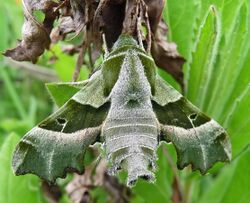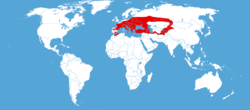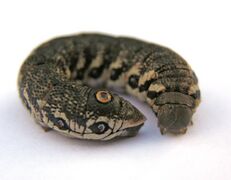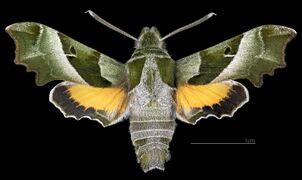Biology:Willowherb hawkmoth
| Willowherb hawkmoth | |
|---|---|

| |
| Scientific classification | |
| Domain: | Eukaryota |
| Kingdom: | Animalia |
| Phylum: | Arthropoda |
| Class: | Insecta |
| Order: | Lepidoptera |
| Family: | Sphingidae |
| Genus: | Proserpinus |
| Species: | P. proserpina
|
| Binomial name | |
| Proserpinus proserpina (Pallas, 1772)[2]
| |

| |
| Synonyms | |
| |
The willowherb hawkmoth (Proserpinus proserpina) is a moth in the family Sphingidae. The species was first described by Peter Simon Pallas in 1772.
Distribution
It is found in Armenia, Austria, Azerbaijan, Belgium, Bulgaria, Denmark , France , Germany , Greece, Hungary, Iran, Iraq, Israel, Italy, Kazakhstan, Lebanon, Morocco, Netherlands, Portugal, Poland Spain , Switzerland , Syria, Turkey, Turkmenistan, Ukraine , Uzbekistan, and Bosnia and Herzegovina.[1]
Description
The wingspan is 36–60 mm. It is highly variable in size but the colour variation is minimal. It is generally a shade of green. Form schmidti has yellow-grey forewings and grey hindwings, form brunnea has a pale leatherish coloration with a reddish median band and form grisea has the green coloration entirely replaced by grey.[3]
Biology
The habitat mainly consists of damp, woodland clearings and edges of woods, especially in valleys. It is also found on sandy waste ground in and around towns. In the Alps, it can be found up to 1,500 meters, in Spain up to 2,000 meters and in Afghanistan up to 1,900 meters. In Europe, there is one generation per year with adults on wing in late May and early June. In the south of the range it is found in mid-May and at higher altitudes in the Pyrenees it is on wing in June and July. There are two generations per year in North Africa, with adults on wing in March and again from June to July.
The larvae feed on Epilobium (including Epilobium hirsutum), Oenothera and Lythrum species.
References
- ↑ 1.0 1.1 World Conservation Monitoring Centre (1996). "Proserpinus proserpina". IUCN Red List of Threatened Species 1996: e.T18366A8153516. doi:10.2305/IUCN.UK.1996.RLTS.T18366A8153516.en. https://www.iucnredlist.org/species/18366/8153516. Retrieved 18 November 2021.
- ↑ "CATE Creating a Taxonomic eScience - Sphingidae". Cate-sphingidae.org. Archived from the original on 2012-11-05. https://web.archive.org/web/20121105200918/https://www.cate-sphingidae.org/taxonomy/Proserpinus/proserpina.html. Retrieved 2011-10-26.
- ↑ Pittaway, A. R. (2018). "Proserpinus Hübner, [1819"]. http://tpittaway.tripod.com/sphinx/p_pro.htm. Retrieved December 13, 2018.
External links
Wikidata ☰ Q1365048 entry
 |







